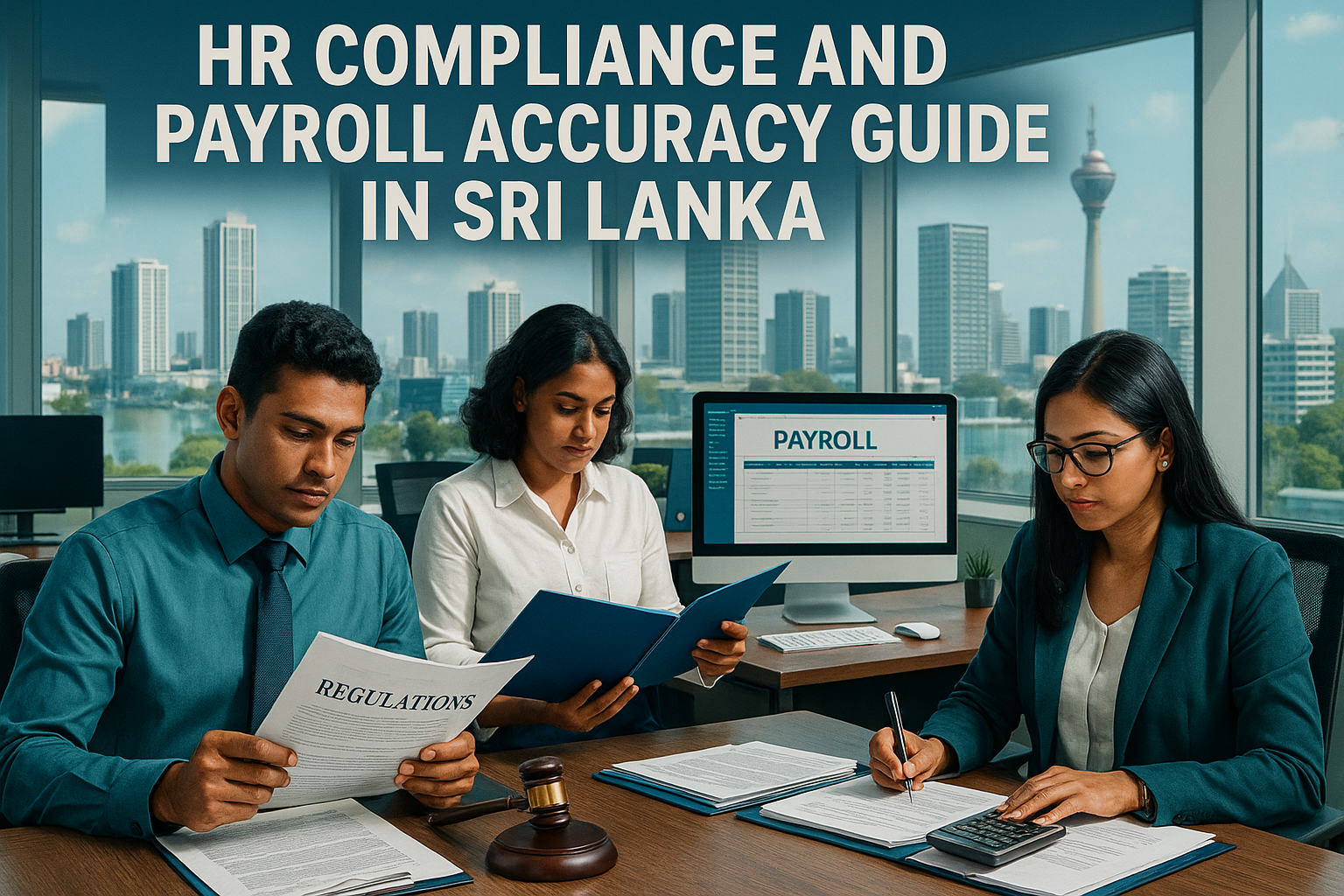Your basket is empty
Already have an account? Log in to check out faster.
Already have an account? Log in to check out faster.

In Sri Lanka's evolving business landscape, maintaining HR compliance while ensuring payroll accuracy has become critical. With frequent regulatory updates and increasing scrutiny, organizations must adopt proactive human resource management approaches.

The Shop and Office Employees Act No. 19 of 1954 governs private sector employment, covering working hours (maximum 45 hours weekly), overtime compensation (1.5x normal rate), and mandatory rest periods. Software companies in Colombo must ensure developers don't exceed 9 hours daily without proper overtime compensation.
The Wages Boards Ordinance establishes minimum wage standards across industries. As of 2025, minimum wages range from LKR 19,500 for service industries to higher specialized sector rates. Garment manufacturers in Katunayake Export Processing Zone must comply with specific wage boards setting different rates than general minimum wages.
EPF Act No. 15 of 1958 and ETF Act No. 46 of 1980 mandate retirement benefits. Employers contribute 12% EPF and 3% ETF; employees contribute 8% EPF. A telecommunications company with 500 employees averaging LKR 75,000 salary manages monthly EPF contributions exceeding LKR 6.75 million.
The Inland Revenue Act No. 24 of 2017 revolutionized tax calculations, introducing new brackets and changing employee benefit taxation. Organizations completely overhauled payroll systems to accommodate these changes.
A multinational bank in Colombo discovered their payroll software couldn't handle complex expatriate employee calculations under new tax laws, requiring complete system upgrades and extensive retraining.

Banking Sector: Must comply with Central Bank regulations on employee conduct and reporting requirements. Recent penalties occurred for failing to report senior management changes within stipulated timeframes.
Export Industries: Companies in Export Processing Zones enjoy tax benefits but must maintain strict Board of Investment compliance. A Biyagama textile manufacturer faced significant back-payments for incorrectly classifying contract workers.
Technology Sector: Growing IT companies face challenges with remote work policies, Data Protection Act compliance, and managing multi-timezone employees under local labor laws.
Payroll errors cost organizations 2-3% of total payroll value annually, including corrections, penalties, and employee relations issues. A retail chain experienced system glitches affecting 2,000+ employees across 50 stores, resulting in LKR 15 million back-payments and LKR 3 million penalty interest.
Basic Salary Compliance: Ensuring minimum wage compliance while maintaining internal equity across multiple salary scales and provincial variations.
Allowances Calculation: Transport, meals, telecommunications, and hardship allowances each have different tax implications. Plantation companies calculate varying allowances for estate workers, supervisors, and management under different wage board decisions.
Overtime and Holiday Pay: Shop and Office Employees Act requires 1.5x overtime rates and double-time holiday pay. Calculations become complex with different base rates, shift differentials, and performance bonuses.
Statutory Deductions: Managing EPF, ETF, income tax, and professional tax while handling exemptions and international tax treaties.
Cloud-Based Platforms: Offer real-time regulatory updates and automatic tax calculations. A telecommunications provider reported 95% payroll error reduction after implementing comprehensive cloud solutions.
HRIS Integration: Eliminates data entry errors and ensures record consistency. Construction companies reduced monthly manual entry by 200 hours and payroll processing time by 60%.
Automated Compliance Reporting: Generates statutory reports automatically, reducing filing errors and missed deadlines for monthly EPF/ETF and quarterly tax returns.
Regular Training: Quarterly HR staff training on regulatory updates. A leading conglomerate's monthly "Compliance Conversations" reduced compliance issues by 40%.
Cross-Departmental Collaboration: HR, finance, and legal departments working together. Hotel chains solving service charge discrepancies required collaboration across all three departments.
Documentation: Maintaining comprehensive payroll transaction records, policy changes, and compliance decisions for inspections and dispute resolutions.
Regular Audits: Quarterly internal audits covering payroll accuracy, statutory compliance, and documentation standards.
Scenario Planning: Contingency plans for regulatory changes, system failures, and employee transfers. Manufacturing companies avoided disruptions through pre-planned scenarios and tested system flexibility.
Vendor Oversight: Strict service provider oversight with performance reviews, compliance certifications, and clear service agreements.
Key Performance Indicators:
Benchmarking: Regular industry peer comparisons and best practice validation.
Manufacturing Excellence: Automotive parts manufacturer with 1,500 employees achieved 99.2% payroll accuracy and 50% processing time reduction through integrated systems and standardized processes.
Retail Transformation: Nationwide chain with 3,000+ employees eliminated regional compliance variations and reduced payroll errors by 85% through centralized processing and automated workflows.
Technology Innovation: Software company scaled from 200 to 800 employees while maintaining compliance standards and reducing per-employee costs by 40% using cloud-based systems.

Digital Transformation: Government digitization initiatives may introduce new electronic filing requirements and data standards.
Enhanced Employee Rights: Evolving labor standards may affect leave policies and working conditions.
ESG Compliance: Growing emphasis on environmental and social governance may introduce employee welfare and diversity reporting requirements.
Achieving HR compliance and payroll accuracy excellence in Sri Lanka requires strategic, forward-thinking approaches anticipating regulatory changes and building resilient systems. Organizations investing in comprehensive frameworks, accurate systems, and continuous improvement create competitive advantages through operational efficiency and employee satisfaction.
Success isn't just avoiding problems—it's creating systems supporting business objectives while maintaining fair employee treatment and corporate responsibility standards. In today's competitive landscape, this approach is essential for sustainable long-term success in Sri Lanka's dynamic economy.
This guide provides general information. Organizations should consult qualified legal and HR professionals for specific compliance requirements.

Don’t miss this opportunity to upgrade your HR operations and join the growing list of businesses in Sri Lanka achieving success with GalleryHR.
GalleryHR is committed to helping Sri Lankan businesses thrive with smarter, more efficient HR solutions. Partner with us today and experience the difference.
Join our empire today!































0 comments